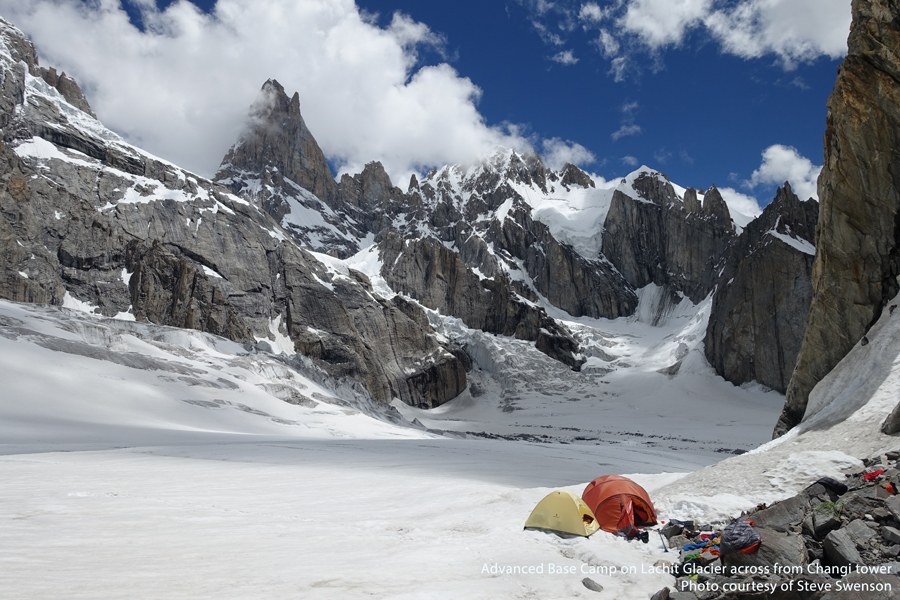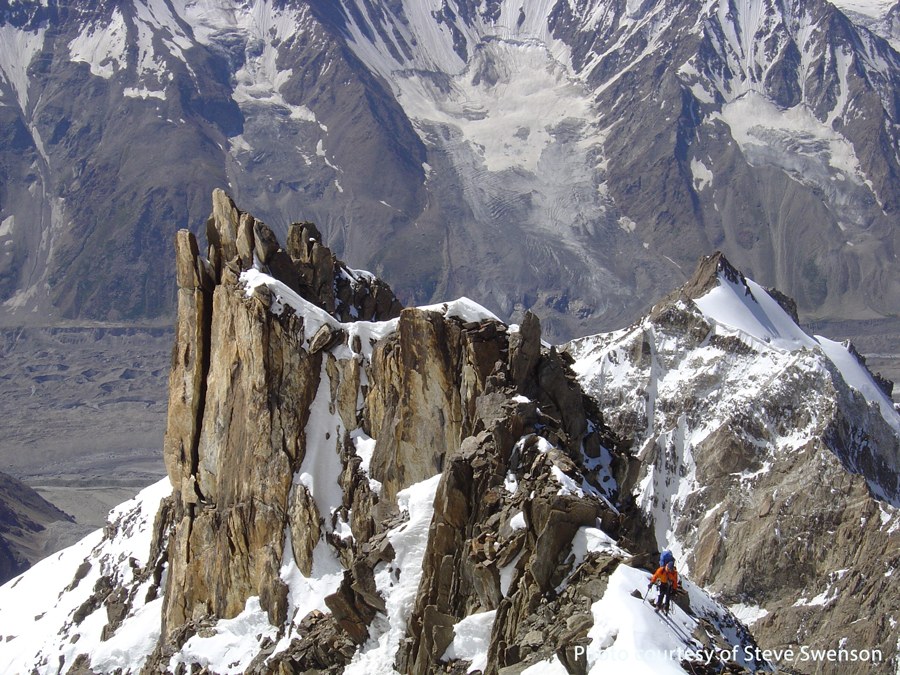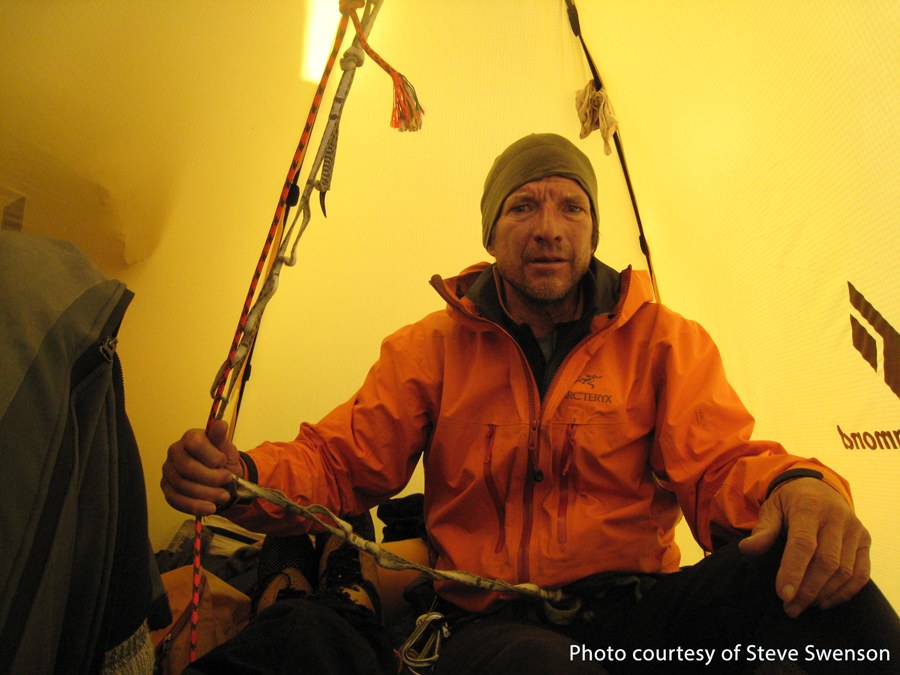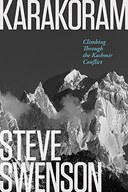
by Julie Briselden, Mountaineers Books Senior Publicist
Steve Swenson, a current Mountaineers Director at Large, has been climbing for more than 45 years. He has made ascents of K2 and Everest, both without supplemental oxygen. In 2012, he and his partners made the first ascent of Saser Kangri II (7518 meters), then the second-highest unclimbed mountain in the world, a feat for which they were awarded the prestigious Piolet d’Or. Steve and his wife, Ann, divide their time between Seattle and Canmore, Alberta.
I sat down with Steve to talk about his new book, Karakoram: Climbing Through the Kashmir Conflict, which is due out in April from Mountaineers Books.
You’ve made innumerable trips over nearly four decades to the Chinese-, Indian-, and Pakistani-administered parts of the Karakoram. What is it about this region that attracts you?
When I went on my first trip to the Karakoram in 1980, it was the climbing objectives that drew me. The Karakoram had been closed to climbing from the early 1960s till the mid-1970s because of the conflict between India and Pakistan over the region. Only the major 8000-meter peaks — K2, Broad Peak, and Gasherbrums I and II — had been climbed. During this period when the Karakoram was closed, most of the major peaks and many difficult new routes were climbed in other parts of the Greater Himalaya. When the Pakistani-administered part of the Karakoram was reopened after a nearly twenty-year closure, the range was a virtual candy store of unclimbed mountains. I was a bit young to be a part of the first wave of climbers to explore new routes and new summits in the Karakoram after it reopened in 1974, but there were still a lot of those kinds of opportunities by the 1980s when I started to become active there.

Karakoram took several years to write; why did you feel compelled to tell this story?
One of the main reasons I wanted to write this story was personal. Over the years, I had tried to balance my climbing avocation with my responsibilities as a parent and husband, and as a colleague in the consulting firm where I worked as an engineer. When I came back from these climbing trips I had to quickly reengage with the non-climbing parts of my life, and what happened while away quickly became dim memories recorded in a stack of journals that collected dust on my bookshelf. I had the opportunity to retire when I was 55, and rather than continue with engineering, I decided to do something different. One of my highest priorities was to explore my feelings about all the adventures that I had never had time to think about. I decided to write about it.
What would you like readers to understand about the experiences you write about?
I tried to show that it took me a long time to learn the right combination of people, objectives, and timing when trying to climb big mountains — and how to blend what might otherwise be conflicting desires for safety, friendship, and success into a common effort. Those were the stars that had to align for us to reach the summits and experience the powerful forces of nature in an intimate way.

You write about your close friendship with Haji Ghulam Rasool, a Balti cook and guide. What is that relationship like and how did it develop over the years?
Rasool is like a brother to me, and one of my dearest friends. We have shared moments of triumph and great tragedy. We have spent time with each other’s families. We take care of each other. Rasool first caught my attention on an expedition to K2 thirty years ago. He exhibited so many ways of entertaining us and relieving the stress of trying to climb such a big dangerous mountain. With each trip we shared together after that, I learned that his antics concealed a deeper understanding of people and their motives. He had been on a lot of expeditions and had seen all kinds of behavior; he appreciated that we cared about him and his family and didn’t try to take advantage of the loyalty he extended to us as his clients. This kind of mutual respect brought us closer to each other in a way that I would not have thought possible between individuals with such different backgrounds. He never learned to read or write, but he is one of the wisest people I know.
How have your experiences shared in the book changed you?
Climbing is what brought me to the Karakoram, but once there I discovered how much these experiences helped me to calibrate my worldview. Most of us have grown up in a life of privilege which limits our ability to understand what real deprivation looks and feels like. These mountains are in very poor and sparsely populated areas, and the lives of the local people we relied on as porters and base camp staff are full of hardship. To survive, villagers have become interdependent and were generous with each other in ways that seemed beyond their means. This was especially true when it came to how they treated us; it was such a contrast to my life at home where we have everything we need and barely know our neighbors, let alone help them out. These people had nothing but wanted to give me everything. It made me realize that the process of climbing these mountains and the values intrinsic to it — like partnership, fortitude, empathy, and humility — were more important than the summits themselves.

Meet Steve April 13

Join us on April 13 as world-class alpinist and author, Steve Swenson takes the stage to feature stories from his latest memoir Karakoram: Climbing Though the Kashmir Conflict.
 Julie Briselden
Julie Briselden
